1. Absolute Maximum Ratings
1-1. Isolation Voltage: BV (Vr.m.s.)
Allowable maximum alternating current voltage that can be applied between the input pins and output pins is expressed as a root mean square (r.m.s.) value.
This value guarantees a certain insulation resistance.
Normally, this value is guaranteed not for an unlimited period, but for a limited test time, of 1 minute, for example.
1-2. Operating Ambient Temperature: TA(°C)
Allowable temperature range in which power application is possible.
Usually when the ambient temperature rises, the power dissipation (PD, PC) declines. Moreover, power application is inhibited when the actual ambient temperature is out of this range.
In the case of photocouplers, the temperature at which power can be applied is not described as the "package surface temperature", but instead as the "ambient temperature (air temperature around the device)".
1-3. Storage Temperature: Tstg(°C)
Allowable temperature range when power is not applied (stored state).
1-4. Light Emitting Diode: Forward Current: IF(mA)
Allowable maximum current at which destruction does not occur, within the allowable power dissipation (PD) range of the LED (light emitting diode) on the light emitting side when the ambient temperature is 25 degree Centigrade.
1-5. Light Emitting Diode: Reverse Voltage: VR(V)
Note that the reverse withstand voltage of the LED (Light Emitting Diode) on the light-emitting side is low.
When the reverse withstand voltage is exceeded, a reverse current suddenly flows. (In this case, the LED does not emit light.)
Moreover, when a reverse current flows, the subsequent light emitting efficiency is lowered.
Therefore, when a reverse voltage exceeding this value is applied even momentarily, destruction or non-recoverable degradation may occur.
However, in case of AC (Alternating Current) input type photocouplers, there is no such value since both of positive and negative voltages are forward voltages.
1-5. Light Emitting Diode: Power Dissipation: PD(mW)
Allowable power dissipation of LED on light-emitting side at ambient temperature of 25 degree Centigrade.
Generally allowable power dissipation (PD) tends to decline as the ambient temperature rises, as shown in the following figure.
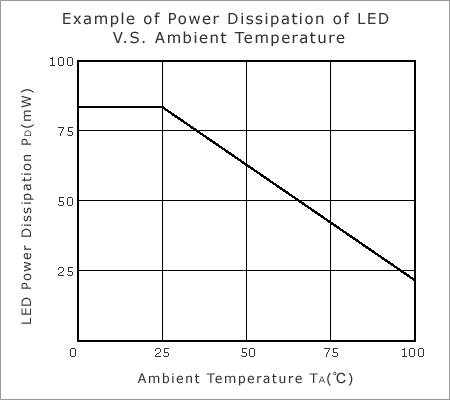
The allowable power dissipation is obtained for the actual maximum ambient temperature from the above "PD-TA" curve.
In addition to the absolute maximum rating of the "Light Emitting Diode: Forward current (IF)", when a forward current (IF) that exceeds the value obtained by dividing this allowable power dissipation by the forward voltage (VF) flows, destruction or non-recoverable degradation may occur.
1-6. Photo-transistor: Power Dissipation: PC(mW)
Allowable power dissipation of light-receiving photo-transistor when the ambient temperature is 25 degree Centigrade.
Generally, the allowable power dissipation (PC) tends to decline as the ambient temperature rises, as shown in the following figure.
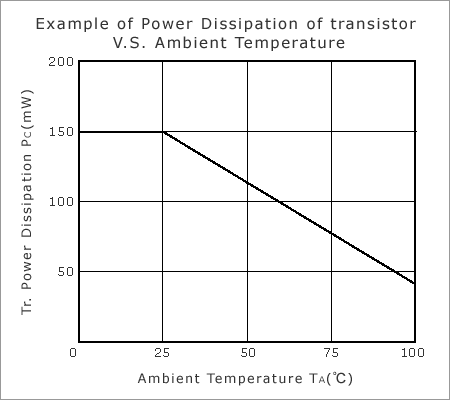
The power dissipation is obtained for the actual maximum ambient temperature from the above "PC-TA" curve.
In addition to the absolute maximum rating for the "Photo-transistor: Collector current(IC)", when a collector current (IC) that exceeds the value obtained by dividing this value by the collector-to-emitter voltage (VCE), destruction or non-recoverable degradation may occur.
1-7. Photo-transistor: Collector to Emitter Voltage: VCEO(V)
Allowable maximum voltage that can be applied between collector and emitter of photo-transistor on light-receiving side when no forward current flows through the LED on the light-emitting side (when LED does not emit light).
Generally, when the power supply voltage approaches this value, the transient operation locus cannot be kept within the allowable power dissipation range for the actual maximum ambient temperature during switching, and destruction by excess power loss may occur in the moment of switching operation.
Note that and keep the power supply voltage within a sufficient safe range so that excess power loss does not occur even in such transient time.
1-8. Photo-transistor: Emitter to Collector Voltage: VECO(V)
Allowable reverse voltage that can be applied to photo-transistor on the light-receiving side. Generally, this voltage depends on the reverse withstand voltage between the emitter and base of the photo-transistor and is low.
If a reverse voltage that exceeds this value even momentarily is applied, destruction or non-recoverable degradation may occur.
1-9. Photo-transistor: Collector Current: IC(mA)
Allowable maximum collector current that can flow through a photo-transistor within the allowable power dissipation (PC) range when the light-receiving photo-transistor is conducting current at an ambient temperature of 25 degree Centigrade.
2. Electrical Characteristics
2-1. Current Transfer Ratio: CTR(%)
Value that expresses the collector current (IC) ratio in relation to a prescribed forward current (IF), when a given collector-to-emitter voltage (VCE) is applied to the light-receiving photo-transistor.
CTR (%) = 100 x IC/IF
Even in the photo-diode light-receiving type shown in the following figure, this value is defined as the collector current (IC) ratio in relation to a prescribed forward current (IF) flows through the light emitting diode.
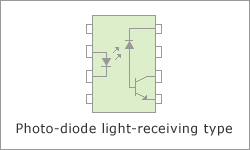
Generally, CTR varies according to the forward current (IF), ambient temperature (TA), or the collector-to-emitter voltage (VCE) in actual.
It also changes over time according to the actual ambient temperature (TA) and forward current (IF) during use.
When actually using a photocoupler, obtain the minimum forward current (IF) value required for conducting the prescribed collector current (IC) into the light-receiving photo-transistor, for the ambient temperature (TA), collector-to-emitter voltage (VCE), and total operating time, using the CTR-IF curve, CTR-TA curve, VCE-IC curve, and long term CTR degradation curve, and perform design the forward current (IF) value equal to or greater to that minimum value.
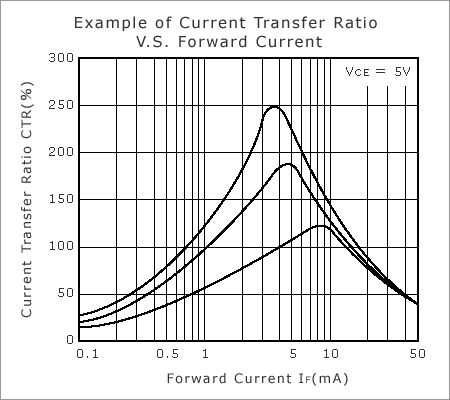
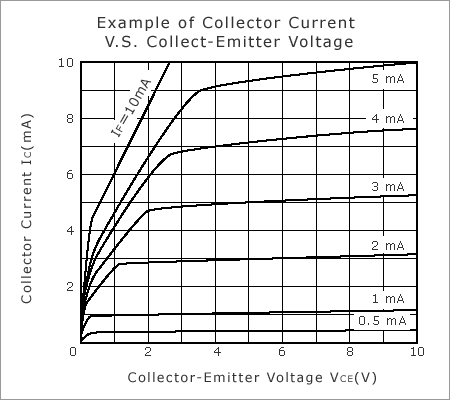
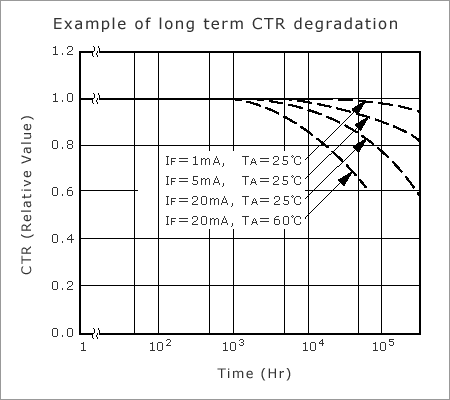
2-2. Isolation Resistance: RI-O(Ω)
Initial insulation resistance when a high direct-current voltage is applied between the input and output pins.
Since the isolation resistance may decline depending on the usage environment, such as the humidity, or the application time of the voltage, perform design and testing taking into consideration actual usage conditions.
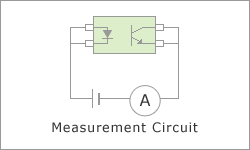
2-3. Isolation Capacitance: CI-O(pF)
Capacitance when a high-frequency signal is applied between input and output pins.
A sudden change of the electric potential difference between the input pin and output pin may cause noise in the output through this capacitance.
Therefore, some products prescribes the immunity to such transient as specification of "Common mode transient immunity (CM)".
Since this value may increase depending on the wiring conditions, etc., perform design and testing taking into consideration such factors during actual use.
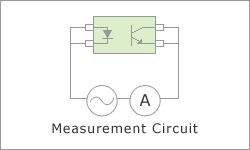
2-4. Common Mode Transient Immunity: CM(kV/µs)
When a sudden change of pulse is applied between the input and output pins while a load resistor is connected to the output photo-transistor and a power source is applied, some noise may be caused in the collector-to-emitter voltage of the output photo-transistor.
This is defined as the pulse's rising/falling speed when such output noise voltage below is a prescribed level.
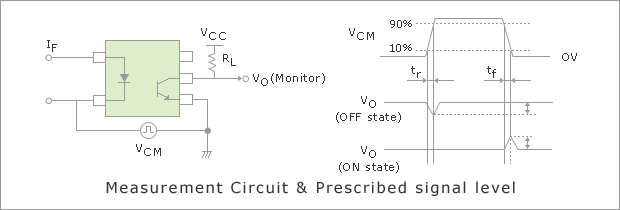
2-5. Light Emitting Diode: Forward Voltage: VF(V)
Inter-pin voltage when a forward current flows through a LED on the light-emitting side.
The product of this value and the forward current value expresses the internal loss of the light-emitting side.
Generally the increasing of the forward current or the falling of the ambient temperature causes rising of the VF voltage.
2-6. Light Emitting Diode: Reverse Current: IR(µA)
This current flows when a prescribed reverse voltage is applied within the maximum rating range to the LED on the light-emitting side.
Generally the increasing of the reverse voltage or the rising of the ambient temperature causes increasing of this current.
In the case of circuits in which a reverse voltage is applied to the LED, design the drive circuit taking into consideration that this value is affected by usage conditions.
2-7. Light Emitting Diode: Terminal Capacitance: Ct(pF)
Capacitance between LED pins on the light-emitting side.
Mainly when a photocoupler is turned off, if the electric charge accumulated in this capacitance is not quickly discharged, a small current is continuously discharged through the LED and as a result turning off of the output is delayed.
If the drive circuit features a switch in parallel with the LED, as shown in the left figure below, when the LED is turned off, there is no problem since the electric charge is quickly discharged via this switch.
On the other hand, if the switch is placed in series with the LED as shown in the right figure, faster turn-off characteristics can be obtained by placing a discharge resistor in parallel with the LED.
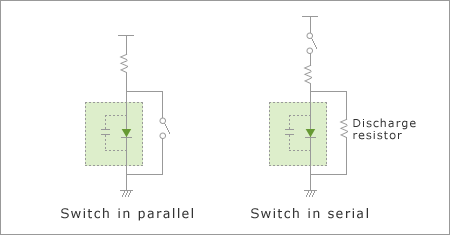
If the LED is driven by logic gate, a switch is provided both in series and in parallel. Therefore, basically discharge occurs quickly.
However in the case of logic gate with a low drive capability, or gate with high saturation output voltage, it may be necessary to provide a discharge resistor in parallel.
2-8. Photo-transistor: Collector to Emitter Dark Current: ICEO(nA)
Leakage current of the collector of the photo-transistor on the light-receiving side, when no forward current flows through the LED on the light-emitting side (in which case the LED does not emit light).
Generally the increasing of the power supply voltage or the raising of the ambient temperature causes increasing of this current.
Regarding the value of the load resistor, design must be performed taking into consideration the maximum value of this current within the usage condition ranges.
2-9. Photo-transistor: Collector Saturation Voltage: VCE(sat)(V)
Collector-to-emitter voltage in relation to a prescribed collector current(IC) of the photo-transistor on the light-receiving side, when a prescribed forward current(IF) flows through the LED on the light-emitting side.
Since this voltage changes greatly depending on the forward current(IF), collector current(IC), and also individual variations in the current transfer ratio (CTR) and its degradation, the forward current and collector current values must be designed taking these factors into careful consideration.
2-10. Rise Time/ Fall Time:tr, tf(µs)
Transient change time of the output voltage when the output is switched ON/OFF while a forward current (IF) flows through a LED on the light-emitting side as a pulse.
The inverse number of the sum of these two values is almost proportional to the maximum operating frequency for the drive conditions.
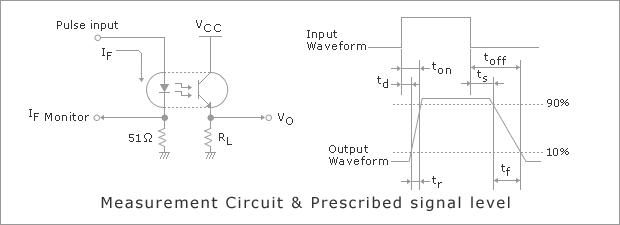
2-11. Propagation Delay Time: tP(µs)
Delay time from forward current change to output voltage change, when a forward current (IF) flows through a LED on the light-emitting side as a pulse.
It resembles "Rise Time/Fall Time", but the definitions are different. The "Propagation delay time" means the time from input change to output change.
When the angle for the drive signal cycle is defined as 360 degree (2π radians), the angle value corresponding to this value is almost equal to the signal phase delay.

The mechanism by which the propagation delay time is generated is the same as that for usual transistors, but in the case of photocouplers, it is basically not possible to temporarily convert the base potential into a reverse bias to reduce the delay at turn-off as can be done for usual transistors.
Basically you had better select a product based on sufficient operation speed. However, if the occurrence of slow operation products due to variation is a possibility, this may be improved by limiting ranking in the case of products with a current transfer ratio (CTR) ranking.